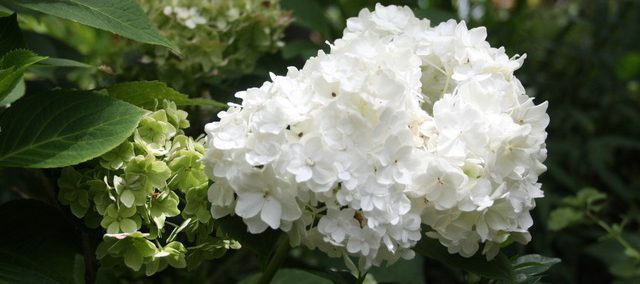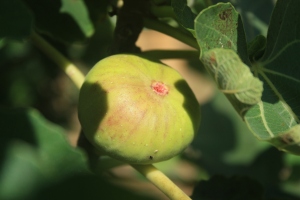Mid-March and officially it is autumn in Brisbane but the hot 30° days continue; I am still struggling to sleep at night unless the air-conditioning is on and I sit in summer clothes under a fan at my desk. My husband knows it is autumn because the wisteria is dropping its leaves and gives him an opportunity to use his new toy, the noisy leaf sucker
I know it is autumn because the last of summer’s green figs are struggling to ripen and the large leaves have become brittle. I am greedy and mourn the luscious fruit, on which we have been feasting over this long hot summer. We have eaten fresh figs drizzled with balsamic vinegar in salads, figs wrapped in pastry or prosciutto, with yoghurt for breakfast, with chocolate and coffee, in friands and in jam. It is the glowing amber coloured jam that enables me to enjoy summer in the dreary months of winter because this year our tree started to produce so many figs we couldn’t eat them fast enough and these ended up in homemade Burnt Fig Jam.
My first experience of the green fig was with a charming elderly Italian man who lived in a tiny hill-top village in the Lunigiana region of Italy. We had rented a small house in the village and we were sitting in the late afternoon breeze on the terrace overlooking the valley, enjoying the isolation and peace after noisy intense London. I watched as an elderly man approached the huge fig tree growing on the slope below the terrace and started picking the large bright green figs. I was curious about what he was going to do with unripe figs so I wandered down and with pitiful Italian language skills I asked about the fruit. His English matched my Italian so we had a happy afternoon, using sign language and smiles as he showed me how he tested the softness of the fruit to determine the ripeness and then we ate some of these luscious sweet figs. I later put them into a rocket salad and they were delicious with the balsamic dressing. That was the beginning of my passionate affair with green figs.
As soon as I moved back to Brisbane I planted the White Adriatic fig and it has been bearing fruit since its first year. Its fruit have a lime green edible skin and a bright pink inside. Rarely do you see these offered for sale; generally it is the more common brown turkey variety with brownish skin and darker pink flesh.
The fig tree is a beautiful tree with large deep green segmented leaves but no flowers as the flower is inside the fruit. The leaves are rough and abrasive. Be careful because they contain an allergen and it doesn’t seem to matter how careful I am when picking the fruit, I still end up with itchy skin from accidentally touching the leaves. The white sap is also a skin irritant. The best way to pick the fruit that nestles against the leaf axil is to wait until it feels slightly soft to the touch and then twist it off the branch so that you don’t tear the skin. Once picked they don’t continue to ripen and bruise very easily.
Each time I look at my fig tree I am entertained with the images of beautiful bodies in art that have had fig leaves added for decorum by puritanical and uptight societies. I blame Adam and Eve for this. There is such a history in the fig and its fruit. Cleopatra is thought to have been killed by the asp hiding in a basket of figs and who can forget Hermione eating the fig in Ken Russell’s 1969 adaptation of DH Lawrence’s’ book written in 1921, Women in Love.
Fortunately the only snake I find in my tree is the occasional green tree snake. In our tropical weather it is usually a battle between the ants, the birds, the possums, fruit bats and me as to who gets to the figs first. I win by picking them late afternoon.
One of my favourite breakfasts is to have sour dough toast and burnt fig jam that glistens in the early morning light with a glowing amber quality. It is such an easy jam to make and a great way to use the slightly over-ripe or bruised fruit. I use my Grandmother’s manner of making jam. Measure the fruit and add half the weight of the fruit in sugar, plus a little water and lemon juice from a homegrown lemon. Cook until when tested on a chilled plate it starts to set and voila! You have jam. However, I have written a recipe down for it so that I can pass this pleasure on to my children.
Burnt Fig Jam
| Figs from the fruit tree
White sugar – about half the weight of the fruit Juice of a lemon and the rind finely sliced or grated 1 tablespoon of dark honey |
Cut the figs into quarters and mix with the sugar, lemon rind and lemon juice.
Place in a saucepan over a medium heat and stir until sugar dissolves. The figs will exude a delicious juice. Bring to the boil then reduce the heat and allow to simmer until the fruit starts to fall apart. This takes about 15 to 30 minutes. At this stage it is a good idea to remove the fruit so that it doesn’t become reduced to a pulp. You don’t have to and the jam is lovely whether you remove the fruit or not. If you want the burnt taste it helps to add a little dark honey. Add the honey and continue to cook the liquid, stirring gently to avoid burning the bottom of the jam. This takes about another 10 to 15 minutes and you have to be vigilant to avoid the jam burning which will give a bitter taste. You can test to see whether the jam has reached setting point by dropping a small amount on a chilled plate that has been sitting in the fridge. If a skin starts to form on the jam it is ready. Turn off the heat and pour into clean sterilised jars. This is a very thick almost toffee like jam that is delicious either with sour dough toast or on a cheese platter. |





